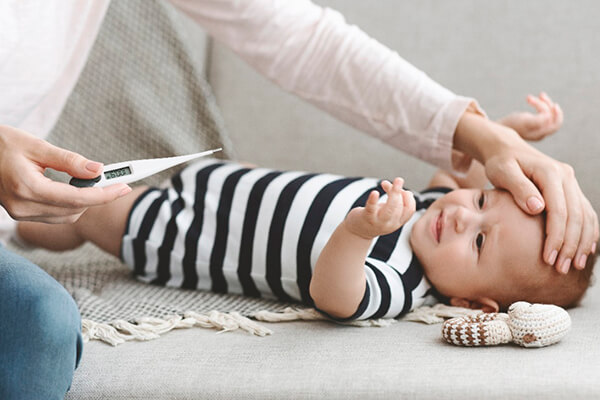What I should know about fever in children
Pediatrics
Author: Cristina MuñozModified date:

What to do if my baby does not lower the fever?
Fever is a response of the body to an infection or other disease that stimulates the immune system and therefore helps to defend against these by stimulating leukocytes and other defense substances. If your baby has a fever, the cause must be investigated and the most important thing is to control the discomfort it produces, physical means and medications prescribed by your doctor can be performed according to the child's weight and age.
How can I lower the fever to the child?
Most of the time it is due to a viral disease and improvement alone is a defense mechanism against an infection or other disease if you have discomfort or rise above 38.5 it can:
- Administer with acetaminophen dosed by your doctor based on your weight and age. You should not use aspirin
- Hydrate with oral liquids
- Put on light clothes.
How long should I wait to go to the emergency room if my child has a fever?
Fever, which is the rise in temperature above 37.3 in the armpit and is regulated by the hypothalamus for each condition and never rises to life risks, usually in children is triggered by a viral infectious process that heals itself; if it is seen in good condition, it must be hydrated, monitored and the pediatrician must be consulted according to the evolution. The symptoms that accompany the fever are those that guide its cause and the reason for going to the emergency department; In case of being drowsy, of bad color, breathing fast, with associated symptoms of vomiting, food refusal or edema of the joints, it is necessary to consult immediately.
What temperature is considered fever in a child?
It is the elevation of the temperature above 37.3 at the axillary level or 38 degrees at the rectal and auditory level that is the most accurate site of the taking.
The normal temperature ranges from 36 to 37.3 and varies according to age, temperature collection site and circadian rhythm.
How many days of fever does a viral process cause?
Depends on the virus; It depends on the child's immune system and it depends on them letting the immune system work - most viral processes last 3 to 5 days but can sometimes be prolonged like the case of the epstein baar virus.
How do you know if the fever is viral or bacterial?
Bacterial fever is associated with undesirable symptoms - it is usually very high and is accompanied by shivering associated with changes in alertness, trouble breathing, stiff neck and staring, dehydration, poor skin color. This is reticulated in appearance and difficult to respond to acetaminophen.
Virally caused fever does not affect the general condition and responds easily to antipyretics.
My son has a fever, but he looks fine. Should I be concerned?
If the child does not have any warning signs and is fine, there is no need to worry. Hydrate, feed and control general discomfort while limiting the viral infectious process.
- In children under 28 days, go to the emergency department or call your doctor.
- In children under 90 days there is a risk of bacterial infections. See if in 24 hours the general condition is unusual or fever persists.
- If the temperature is below 38 degrees, use physical means (water compresses or bath at room temperature).
- Take a temperature measurement with a digital thermometer calibrated in the armpit for 3 to 5 min (unzip the child).
- Know the antipyretic (ideally acetaminophen) suitable for your child's weight.
- Wait 45 min to 1 h for the medicine to work, it is not immediate.
- Do not use alcohol or cold water. Produces vasoconstriction, does not allow heat to dissipate.
- Do not use aspirin in children.
- Do not use ibuprofen in children under 6 months.
- Consult the emergency department if you have drowsiness, food refusal, seizures, vomiting, purple skin and mucosa or symptoms of localized pain.
- Keep calm and if it's okay to let him sleep, don't lift him to give him antipyretics.